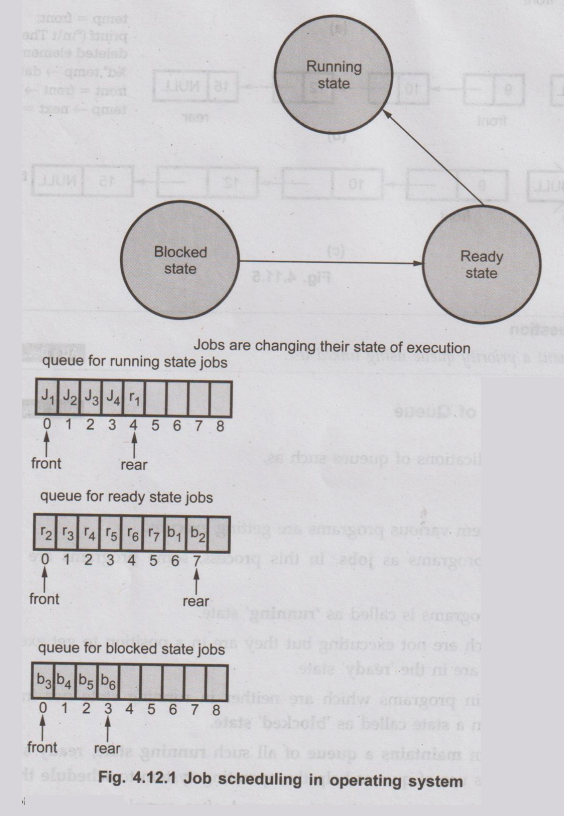C Programming and Data Structures: Unit III: b. Linear Data Structures Stacks and Queues
Applications of Queue
Operations, Example C programs
The operating system maintains a queue of all such running state, ready state, blocked state programs. Thus use of queues help the operating system to schedule the jobs.
Applications
of Queue
AU: Dec.-19, Marks 15
There
are various applications of queues such as,
1. Job Scheduling
•
In the operating system various programs are getting executed.
•
We will call these programs as jobs.
In this process, some programs are in executing state.
•
The state of these programs is called as 'running'
state.
•
Some programs which are not executing but they are in a position to get
executed at any time such programs are in the 'ready' state.
•
And there are certain programs which are neither in running state nor in ready
state. Such programs are in a state called as 'blocked' state.
•
The operating system maintains a queue
of all such running state, ready state,
blocked state programs. Thus use of queues help the operating system to schedule the jobs.
•
The jobs which are in running state are removed after complete execution of
each job, then the jobs which are in ready state change their state from ready
to running and get entered in the queue for running state.
•
Similarly the jobs which are in blocked state can change their state from
blocked to ready state.
•
These jobs then can be entered in the queue for ready state jobs.
•
Thus every job changes its state and finally get executed. Refer Fig. 4.12.1.
•
Thus queues are effectively used in the operating system for scheduling the
jobs.

Categorizing Data
•
The queue can be used to categorize the data.
•
The typical example for categorizing the data is our college library.
•
The college can have several departments such as Computer Engineering,
Information Technology, Mechanical Engineering, Electronics Engineering and so
on. The library has various sections in which the books from each stream are
arranged.
•
These sections are like multiple queues in which appropriate data (books) are
stored. Thus categorization of data can be possible using multiple queues.
Ex. 4.12.1: There are 'N' numbers of balls in the box. The colors of the balls are
red and blue. You are requested to stack the balls in the bottom sealed basket
one by one. The order of placing the balls is two consecutive red balls
followed by two consecutive blue balls. Later create two empty queues Q1 and
Q2. Remove the last inserted balls from the basket and place it in Q1. Similarly
remove the next inserted balls from the basket and insert it in Q2. Develop a
program to repeat this process until the basket is empty and also print the
color of the balls in both queues. AU: Dec.-19, Marks 15
Sol. :
#include<stdio.h>
#include<conio.h>
#include<stdlib.h>
#define
size 25
/*
stack structure*/
struct
stack
{
char
s[size];
int
top;
}st;
struct
queue
{
char
que[size];
int
front,rear;
}Q1,
Q2;
int
stfull()
{
if(st.top>=size
- 1)
return
1;
else
return
0;
}
void
push()
{
for(int
i=0;i<2;i++)
{
st.top++;
st.s[st.top]='r';
}
for(int
i=0;i<2;i++)
{
st.top++;
st.s[st.top]='b';
tex
}
printf("\n
Balls are Pushed !!!");
}
int
stempty()
{
if(st.top==
-1)
return
1;
else
return
0;
}
char
pop()
{
char
item;
item=st.s[st.top];
st.top--;
printf("\n
Ball is popped");
return(item);
}
void
insert_Queue1 (char item)
{
printf("\n
Inserting ball in Q1");
if(Q1.front
== -1)
Q1.front++;
Q1.que[++Q1.rear]
= item;
}
void
insert_Queue2(char item)
{
printf("\n
Inserting ball in Q2");
if(Q2.front
== -1)
Q2.front++;
Q2.que[++Q2.rear]
= item;
}
void
display_queue(struct queue Q)
{
int
i;
for(i=Q.front;i<=Q.rear;i++)
printf("%c",Q.que[i]);
}
void
display_stack()
{
int
i;
if(stempty())
printf("\n
Stack Is Empty!");
else
{
for(i=st.top;i>=0;i
- -)
printf("\n%c",
st.s[i]);
}
}
int
main(void)
{
int
choice;
char
ans,item;
st.top
= -1;
Q1.front=
-1;
Q1.rear=
-1;
Q2.front=
-1;
Q2.rear
=1;
do
{
printf("\n
Main Menu");
printf("\n1.Push
the balls\n2.Pop\n3.exit");
printf("\n
Enter Your Choice: ");
scanf("%d",
&choice);
switch(choice)
{
case
1:if(stfull())
printf("\n
Stack is Full!");
void
display_queue(struct queue Q)
{
int
i;
for(i=Q.front;i<=Q.rear;i++)
printf("%c",Q.que[i]);
}
void
display_stack()
{
int
i;
if(stempty())
printf("\n
Stack Is Empty!");
else
{
for(i=st.top;i>=0;i
— −)
printf("\n%c",
st.s[i]);
}
}
int
main(void)
{
int
choice;
char
ans,item;
st.top
= -1;
Q1.front
= -1;
Q1.rear
= -1;
Q2.front
= -1;
Q2.rear
= -1;
do
{
printf("\n
Main Menu");
printf("\n1.Push
the balls\n2.Pop\n3.exit");
printf("\n
Enter Your Choice: ");
scanf("%d",
&choice);
switch(choice)
{
case
1:if(stfull())
printf("\n
Stack is Full!");
else
{
push();
display_stack();
}
break;
case
2:if(stempty())
printf("\n
Empty stack!Underflow !!");
else
{
while(!stempty())
{
item=pop();
insert_Queue1(item);
item=pop();
insert_Queue2(item);
printf("\n
Displaying Queue1...\n");
display_queue(Q1);
printf("\n
Displaying Queue2...\n");
display_queue(Q2);
printf("\n----------------------\n");
}
}
display_stack();
break;
case
3:exit(0);
}
printf("\n
Do You want To Continue? ");
ans=getche();
}
while(ans == 'Y' || ans =='y');
getch();
return
0;
Output
Main
Menu
1.Push
the balls
2.Pop
3.exit
Enter
Your Choice: 1
Balls
are Pushed !!!!
b
b
r
r
Do
You want To Continue? y
Main
Menu
1.Push
the balls
2.Pop
3.exit
Enter
Your Choice: 2
Ball
is popped
Inserting
ball in Q1
Ball
is popped og r
Inserting
ball in Q2
Displaying
Queue1...
b
Displaying
Queue2...
b
------------------------
Ball
is popped
Inserting
ball in Q1
Ball
is popped
Inserting
ball in Q2
Displaying
Queue1...
b
r
Displaying
Queue2...
b
r
--------------------------
Stack
Is Empty!
C Programming and Data Structures: Unit III: b. Linear Data Structures Stacks and Queues : Tag: : Operations, Example C programs - Applications of Queue
Related Topics
Related Subjects
C Programming and Data Structures
CS3353 3rd Semester EEE, ECE Dept | 2021 Regulation | 3rd Semester EEE Dept 2021 Regulation
